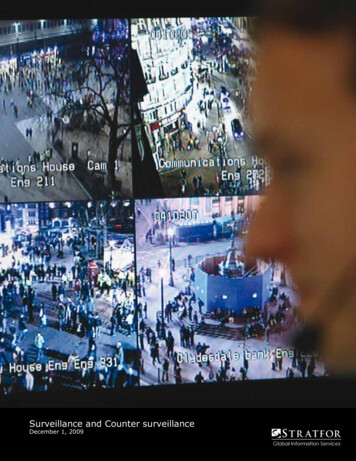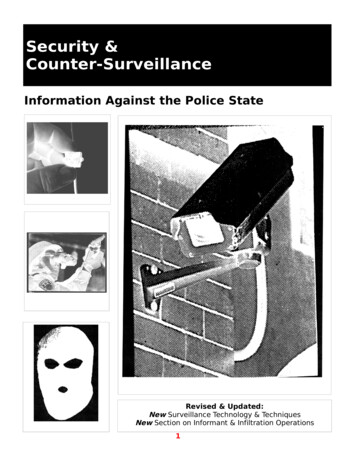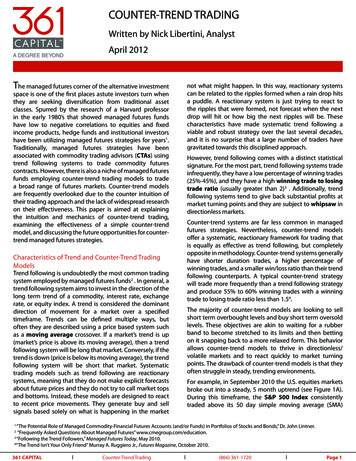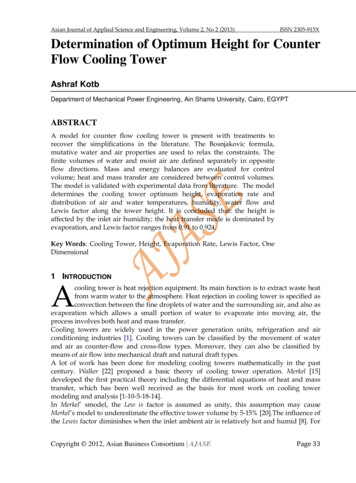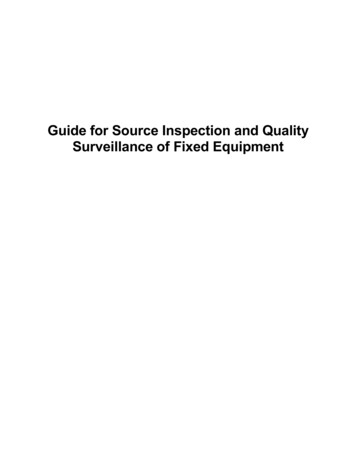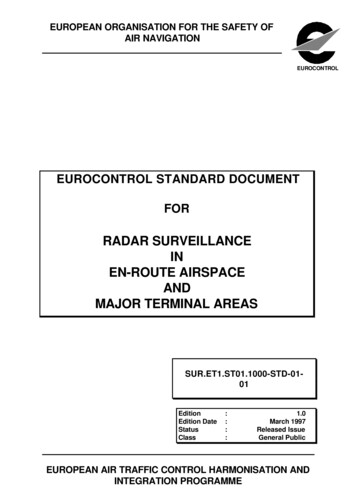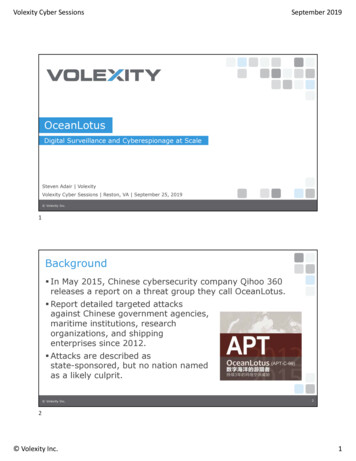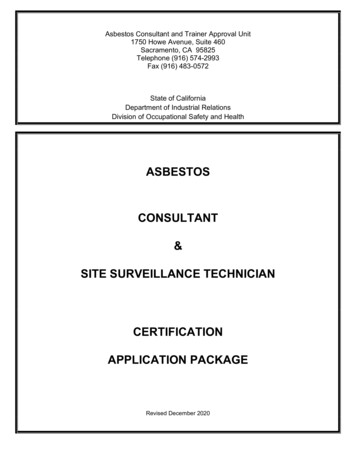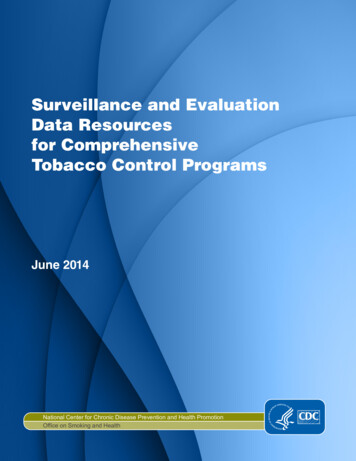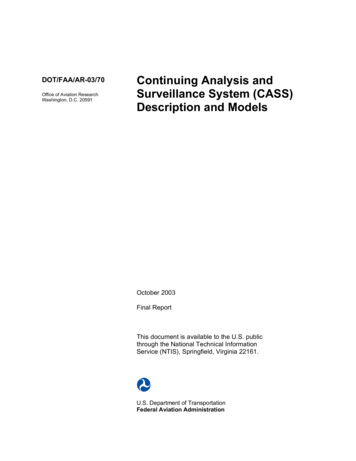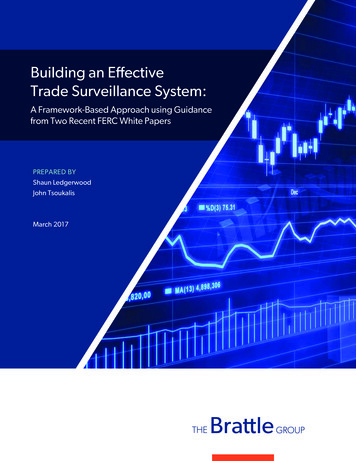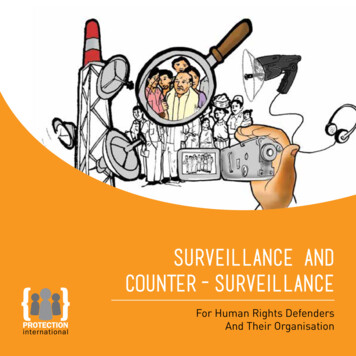
Transcription
SURVEILLANCE ANDCOUNTER-SURVEILLANCEFor Human Rights DefendersAnd Their OrganisationSurveillance and counter-surveillance for human rights defenders and their organisations 1
2 Surveillance and counter-surveillance for human rights defenders and their organisations
SURVEILLANCE ANDCOUNTER-SURVEILLANCEFor Human Rights DefendersAnd Their Organisation
First edition Kenya December 2014, adapted from Cuadernos de Protección 2: Vigilancia ycontravigilancia para Defensoras y Defensores de Derechos Humanos Protection International –UDEFEGUA Guatemala December 2011 ISBN: 978-2-930-539-21-8UDEFEGUA has been monitoring, investigating, documenting and reporting attacks on human rightsdefenders for over ten years. It works in partnership with numerous Guatemalan organisations.UDEFEGUA (Human Rights Defenders Protection Unit Guatemala) and Protection Internationalcollaborated in 2008 to set up a Protection Desk called Aj Noj. In 2014 Aj Noj began to operateindependent of UDEFEGUA.Published by Protection International 201411 Rue de la Linière -1060 Brussels, BelgiumFirst EditionCopyright 2014 from Cuadernos de Protección 2: Vigilancia y contravigilancia para Defensorasy Defensores de Derechos Humanos Protection International –UDEFEGUA Guatemala December2011 ISBN: 978-2-930-539-21-8Participated in the Production of this handbookTranslation- Protection International Head OfficeContent adaptation- Ivy Kihara, Nora Rehmer and Mauricio AngelGraphics adaptation, illustrations and layout- Michael KaringaPD Noj for all necessary supportThis handbook has been produced for the benefit of human rights defenders and may be quoted fromor photocopied for non-commercial purposes as long as the source/authors are acknowledged. Forits inclusion in other publications or other uses, please ask for authorisation.11 Rue de la Linière -1060 Brussels, BelgiumTel: 32 2 609 44 05Fax: 32 536 19 82pi@protectioninternational.org OR kenya@protectioninternational.orgIt can be downloaded for free fromwww.protectioninternational.orgPlease contact us if you would like to get copies of the handbook.ISBN: 978-2-930539-37-9-9782930539379
6 Surveillance and counter-surveillance for human rights defenders and their organisations
Table of contentsChapter 1: INTRODUCTION . 9Chapter 2: STEPS TO TAKE ACTION AGAINST POSSIBLE AGGRESSION . 12Chapter 3: SURVEILLANCE . 15Chapter 4: COUNTER-SURVEILLANCE . 174.1 How to know if we are being watched . 184.2 Counter-surveillance actions to detect cases of surveillance or of being followed. 184.3 Counter-surveillance when coming out of the house or office. 184.4 Counter-surveillance in public transport. 214.5 Counter-surveillance by car. 224.6 Counter-surveillance for female rights defenders. 234.7 Counter-surveillance information to protect information. 24Chapter 5: SYSTEMATISING AND ANALYSING INFORMATION ON THOSE WHO WATCH ORTHREATEN US . 28
Purpose of this bookletBeing a person who assumes the responsibility of defending rights of others is no easy task.Unfortunately, in many cases human rights are at odds with the private interests of powerful actorswho will not hesitate to turn violent. Human rights defenders remind us that human rights must notbe violated, that the collective standards of co-existence are above private profit at any cost. Manydefenders suffer aggressions and persecution, including surveillance to keep them under controland to prepare attacks (aggressions) against them.This booklet aims to provide human rights defenders and their organisations tools to check andcurtail such practices: By engaging in counter-surveillance one can make it more difficult foraggressors to attack so that your security will improve and you can continue with defending humanrights safely.8 Surveillance and counter-surveillance for human rights defenders and their organisations
Chapter 1:INTRODUCTIONSurveillance is the art of observing theactivities of people or groups from aposition of authority or power. It may becovert (without your knowledge) or overt(perhaps with a frequent reminder “we’vegot our eyes on you”). It aims at gatheringinformation on the work of a defenderor his/her organisation to prepare for anaggression or serve as a demonstration ofpotential aggressor’s capacity to harm withthe intention to scare the defender andmaking him/her stop engaging in sensitivework.Surveillance is part of human history. TheArt of War by Sun Tzu, written more than2,500 years ago in China, analyses how spiesshould be used against the enemy. Moderntechnology has given surveillance a newdimension - surveillance can be automatedusing computers and extensive records ofpeople’s activities can be kept over a longperiod of time.Surveillance and counter-surveillance for human rights defenders and their organisations 9
before leavingCounter-surveillance is the practice ofdetecting surveillance i.e. of detectingwhether you are being watched. It is also thepractice of avoiding or making surveillancemore difficult. Before the computer age,counter-surveillanceentailedevadingagents, spies or “ears” and finding waysto communicate secretly. With recentdevelopments such as the Internet,the increased presence of electronicsecurity systems and databases, countersurveillance has grown in scope andcomplexity. Today, it entails nearly all ourareas of work, from knowing how to deletea computerised file without leaving a trace,to avoid being the target of direct advertisingagencies who have gathered informationon your preference through your use of theInternet.10 Surveillance and counter-surveillance for human rights defenders and their organisations
before leavingCounter-surveillance is also geared toreversing the effects of surveillance bytaking away the anonymity of surveillanceand disclosing acts of surveillance and theirperpetrators. It tries to break the secret orrestrictive use of surveillance records, e.g.by citizens requiring that police personnelidentify themselves, questioning peoplesuspected of watching your premises ortaking part in marches and public activitiesto be able to identify infiltrators.Every surveillance action is followed by ananalysis of the information obtained whichyields intelligence.All information obtained from countersurveillance must be analysed by humanrights defenders to gauge the degree of thethreat and assess whether an action is beingprepared against you. Surveillance and counter-surveillance for human rights defenders and their organisations 11
Chapter 2: STEPS TOTAKE ACTION AGAINSTPOSSIBLE AGGRESSIONAny aggression action that an opponent, aggressor or commoncriminal may take against you or your organisation must gothrough three main phases: information, assessment anddecision/action.In the information phase, the aggressors gathers details on yourconduct, the geographic context and appearance that they mayneed for their intentions and in order to be able to assess thefeasibility and expediency of their plan.12 Surveillance and counter-surveillance for human rights defenders and their organisations
STEPS TO TAKE ACTION AGAINST POSSIBLE AGGRESSIONwill be conducted (costbenefit balance sheet)to see if the calculatedbenefit is greater thanthe estimated cost of theaction. Then it is safe todecide to take action.To protect yourselvesfrom aggression, you haveto proceed in the sameway but make a decisionand take action but in anopposite manner:Conceal information frompotential aggressors sothat they cannot identifya target, e.g. that youare carrying valuablesor giving easy accessto sensitive or personalinformation that exposesyourvulnerabilitytoattack such as where yourchildren go to school, yourroutine, when you go outon your days of, etc.The assessment phase is geared towardsdetermining whether the action beingconsidered will produce the desired resultat an affordable cost; a cost/benefit analysisGather information of what is around yousuch as suspicious people or cars, whoapproaches you, who is in the vicinity. Forexample, if there is a policeman or securitySurveillance and counter-surveillance for human rights defenders and their organisations 13
STEPS TO TAKE ACTION AGAINST POSSIBLE AGGRESSIONguard in a nearby shop, how would you beable to leave discretely? If the ongoingassessment of the gathered informationpoints to an attack, you take rapid action foryour protection.In the information phase, we proceed indifferent ways, depending on whether weare protecting or concealing informationabout our activity or private life or whetherwe are gathering information on how we arebeing watched.14 Surveillance and counter-surveillance for human rights defenders and their organisations
assessing a possible aggression or simply tocompile information on how we proceed andto use it where and when deemed necessary.The plethora of means of communicationand technology for information gatheringpurposes, whether images, recordings etc.,makes this activity constantly more complexand difficult to detect.Surveillance may imply a threat, if it involvesimmediate action, or not, if it is limited tosimply gathering information for the timebeing.We must bear in mind the risk at whichwe may be placing other people if we arewatched and followed. For example, wemight deliver witnesses or victims to thosewho are watching us when we attendmeetings with them, whereby they becometargets too.As we shall see in the next chapter, we have toorganise counter-surveillance assignmentsto find out whether we are being watched.Chapter 3:SURVEILLANCESurveillance is carried out through manymeans and always has a goal. It is geared tocollecting information on the environment ofour organisation or ourselves, with a view toBy whom and how can we be watched?We can be watched by people in theneighbourhood, watchmen, vendors, peoplewaiting in cars, people who pay us visits,etc. They keep us under watch for money,because they have been pressured intodoing so (out of fear), because they considerit necessary (owing to ideology), or becauseof a combination of these factors.Surveillance and counter-surveillance for human rights defenders and their organisations 15
SURVEILLANCEThose who order that we be watched mayalso send operatives or members of theirorganisations in areas where we happen tobe. They may also follow us from a distance.In such a case, they will normally be membersof an organised institution or group and willuse tactics in following us so that we arenot aware of it. They will thus keep a safedistance, turn and change location, vehicle,etc. Such modes of surveillance include: Watching and following on foot, bymotorcycle or car. Investigating and questioning our friendsor neighbours. Telephone tapping, interception ofSMSs, stealing address books or otherinformation found on mobile phones. Determining where we are located bymeans of a mobile phone GPS. Tracking information posted on socialnetworks, web pages, blogs, etc. Intercepting e-mails, chats and calls viathe Internet. Stealing computers, USBs and otherportable digital storage systems, externaldiscs, etc. Recording images using still photographyor video cameras. Gathering information by going throughour papers in the rubbish bin.16 Surveillance and counter-surveillance for human rights defenders and their organisations
Chapter 4:COUNTERSURVEILLANCECounter-surveillance is the action carriedout to counter surveillance or intelligence.To carry out counter-surveillance, we must: Observe our environment actively todetect any surveillance action and reactaccordingly (seeking protection and/ortrying to obtain proof of surveillance forsubsequent complaints or investigations). Prevent those who are watching us fromobtaining information from us (by anymeans at their disposal).Surveillance and counter-surveillance for human rights defenders and their organisations 17
COUNTER-SURVEILLANCE4.1 How to know if we are beingwatchedLogic dictates that it is wise to check if weare under surveillance if we have reason tobelieve that we are – for example because ofsecurity incidents which could be related tosurveillance.If our human rights work carries a certainrisk, it is a good idea to conduct a simplecounter-surveillance exercise from time totime, just in case. We must not howeverbecome constantly concerned if we do nothave grounds for being overly cautious.Many of the actions proposed in this chaptercannot be carried out every day, becausethey are tiring. But they are important ifwe suspect that we are being watched. Wetherefore have to be very alert.4.2 Counter-surveillance actions todetect cases of surveillance or ofbeing followedIf you manage to document actions ofsurveillance, including threats, you willbe able to conduct a better analysis andto demonstrate publicly that such actionsare being waged against you, for instancethat such an actor is gathering informationon you or the organisation, and in so doingexpose him. They may be dissuaded if theysee that you are recording the movementsthat are taken place in your environment orduring public activities, and such actions canprovide proof in case of aggression againstyou. These include: Filmi
Surveillance and counter-surveillance for human rights defenders and their organisations 15 Chapter 3: SURVEILLANCE Surveillance is carried out through many means and always has a goal. It is geared to collecting information on the environment of our organisation or ourselves, with a view to assessing a possible aggression or simply to compile information on how we proceed and to use it .
